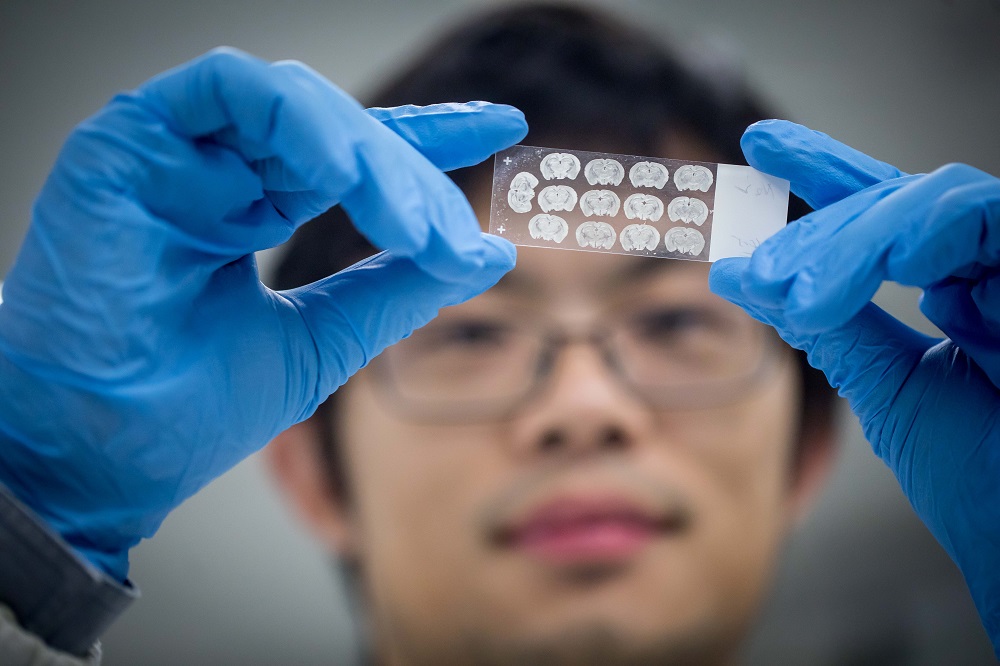From Memory Formation to Treatment of Brain Disorders
How memories are formed has long been a fundamental question for neuroscientists. Studies by Professor He Jufang, Wong Chun Hong Chair Professor of Translational Neuroscience in the Department of Neuroscience and Department of Biomedical Sciences, have shed light on the crucial role of a key neuromodulator, called cholecystokinin (CCK), in memory forming in the neocortex. As a result of the discovery of CCK’s functions, Professor He is developing a treatment strategy to alleviate epilepsy, tinnitus, Alzheimer’s disease, and other brain disorders.
Memory is stored in a network of neurons through the persistent changes in the strength of connections between neurons, described as synaptic plasticity. These connections, called synapses, allow neurons to communicate with each other. The strength of communication, called synaptic strength, can be modified, depending on how often these connections are activated. The more active the connections are, the stronger they become. The lasting increase in synaptic strength is called long-term potentiation (LTP). And long-term synaptic plasticity forms the model for memory storage.
Discovery of crucial neuromodulator in memory formation

During the communication between two neurons across a synapse, an electric signal is converted into a chemical signal, in the form of neurotransmitter release. Upon binding to the receptor, the transmitter switches back into an electric form travelling through the neuron.
By investigating the chemical composition of dozens of neurotransmitters and neuromodulators in the medial temporal lobe, Professor He and his team discovered that CCK is crucial in switching on memory writing in the neocortex. In particular, they found out how memory is encoded and how visual and auditory inputs are associated.
Subsequently, they found that the N-methyl-D-aspartate (NMDA) receptor, which was once widely recognised as the most important receptor in mediating the formation of memory, actually controls the release of CCK. And it is CCK that induces long-term synaptic plasticity, enabling memory formation.
While their discovery is about memory formation, its implications and application potential extend further. “Epilepsy and many neurodegenerative diseases, such as Alzheimer’s, are strongly associated with synaptic plasticity in the brain,” said Professor He. “Our findings revealing the relationship among CCK, LTP and synaptic plasticity provide a theoretical basis for developing treatments for different brain diseases.”
For instance, they are studying the relationship between high-frequency stimulation-induced LTP in the hippocampus and CCK, and between spatial memory and CCK. In particular, they will examine whether CCK agonists (chemicals act like CCK and therefore stimulate the same receptors) can rescue spatial learning in memory-deficient mice, with the long-term goal of future drug development to help patients with Alzheimer’s or neurological disorders retain memory.
Treatment strategy for tinnitus
The team is also investigating the possibility of treating tinnitus with the administration of CCK4, a type of CCK agonist, paired with sound therapy.
Tinnitus patients hear phantom sounds, like clicking, buzzing or ringing. Tinnitus alone can severely disrupt quality of life. The majority of tinnitus cases occur after patients suffer from peripheral hearing loss because of exposure to either long-term loud noise or a blast. In a fraction of cases, the brain is incapable of compensating for the loss of major ascending cochlear input to the major centres of the central auditory pathway, namely the auditory thalamus and auditory cortex. Neurons that lose cochlear input in these brain regions become hypersensitive and show synchronised activity, called thalamocortical oscillations. This constant activity in the loop can be perceived as a constant phantom sound, tinnitus.
“We plan to apply CCK agonists to patients to activate plasticity in the brain, and then apply sound therapy to rewire synaptic connections in the thalamocortical complex,” said Professor He. “The novelty of our approach involves triggering synaptic plasticity in the brain through the administration of CCK4. Preliminary results show a promising outcome.”
Application in alleviating epilepsy
Moreover, inhibiting CCK activation may help alleviate involuntary seizures in epilepsy patients.
Epilepsy is one of the most prevalent neurological disorders characterised by spontaneous recurrent seizures. “Anti-epileptic drugs have been used as long-term treatment solutions. But 35% of patients have been found to become resistant to the medication. Temporal lobe epilepsy is one of the most severe and frequent pharmaco-resistant types of epilepsies,” explained Professor He.
After having established the link between epilepsy and the strengthening of the neural network with CCK from the medial temporal lobe, the team will explore a treatment strategy by blocking the synaptic strength with CCK receptor antagonists.
This research article originated from CityU RESEARCH.